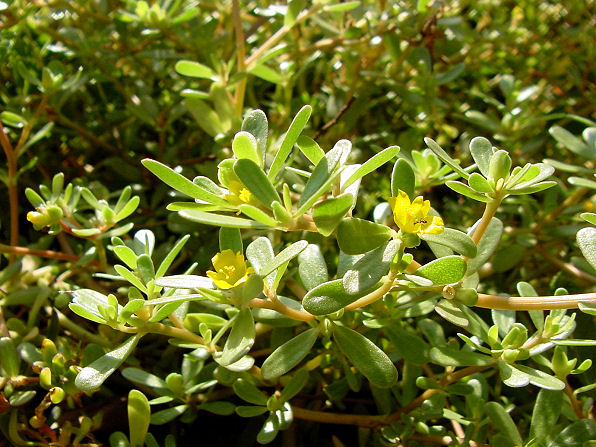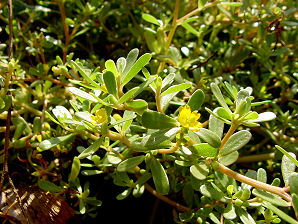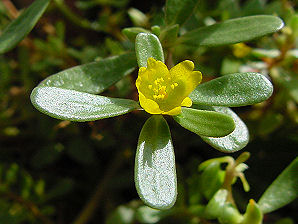Arizona Wild Flowers
Pictures, Photos, Images
Descriptions, Information, Reviews.
Purslane, Portulaca oleracea.
We Are Proud Of Our SafeSurf Rating!
Click On Any Of The Following Links By Amazon.Com
For Books, & Videos About Wildflowers Of Arizona & The Southwest USA. No Obligation!
 |
| Purslane, Portulaca oleracea - Photo Taken August 13, 2005 In Glendale. Notice the Flower is being Pollinated By An Ant. |
|---|
 | |
| Purslane, Portulaca oleracea Covers The Ground, Low Growing. | Purslane, Portulaca oleracea Thick Green Leaves. |
|---|---|
 |  |
| The Flower Buds Are Beginning To Open An Hour After Sunrise. | The Flowers Are Open A Half Hour Later. |
Purslane.
We wish to thank Wikipedia, the free encyclopedia for some of the information on this page. We share images and information with Wikipedia. Purslane in the U.S., is considered a herbaceous weed. It is be found growing wild and/or cultivated in much of the world. It existed in the New World before the arrival of Columbus, and was found in Europe by the late 16th century. The main feature of Purslane which raises its status above that of a common weed is its edibility. We find that it has a slight sour - sweet taste. While it is said to be edible, we do not recommend eating any wild plants. The species was well known to the early settlers who often used the juicy leaves in salads and, cooked, as a substitute for spinach. The seeds are also edible and are usually ground and baked. The species was also used for hundreds of diseases. Generally, whatever ails you! It is a prostrate herb with fleshy, reddish stems and thick, succulent leaves which are oval shaped up to about 3/4 inch long. Small yellow flowers occur in the leaf bases. Regulated noxious weed in Arizona. The best way to control it is not to let it get started. To get our photos we let one plant grow in a small garden area and it almost took over in about 30 days.
Quick Notes:
Height: Up to about 16 inches. Spreading out to about 2 - 3 foot wide.
Stems: It has smooth, reddish, mostly prostrate stems.
Flowers: ellow with 5 petals and they are up to 1/5 inches wide. The flowers open in the very early morning and close by about noon. The seed pod breaks in half when the black seeds are ready.
Flowering Time: March to October.
Leaves: The leaves are alternate and broadly obovate. Each succulent leaf is entire and the leaves are clustered at stem joints and ends.
Found: Purslane is a native plant of Persia (Iran) where it was used over 2,000 years ago. It was introduced into the United States from southern Europe. Now it is most abundant in the eastern United States, and the least common in the Pacific Northwest.
Hardiness:
Soil pH requirements:
Sun Exposure:
Elevation: 0 - 9,000 Feet.
Habitat: It can be found growing in almost any unshaded area, including flower beds, fields, and waste places.
Miscellaneous: Flowering Photos Taken August 13, 2005 In Glendale, Arizona.
|
We Are Proud Of Our SafeSurf Rating!
Click On Any Of The Following Links By Amazon.Com
For Books, & Videos About Wildflowers Of Arizona & The Southwest USA. No Obligation!
| © 1966 - Present, Audrey, Eve, & George DeLange |
